Marketing Process & Planning: The Marketing Concept, Functions and Mix
VerifiedAdded on 2023/06/07
|20
|4806
|381
AI Summary
This report from Desklib discusses the marketing concept, functions and mix, and how they contribute to the success of organizations. It also analyzes how marketing interacts with other departments and provides recommendations and an evaluation of the marketing mix adopted by Tesco. The report is relevant to the Higher National Diploma in Business Management, specifically Unit 2 Marketing Process & Planning.
Contribute Materials
Your contribution can guide someone’s learning journey. Share your
documents today.
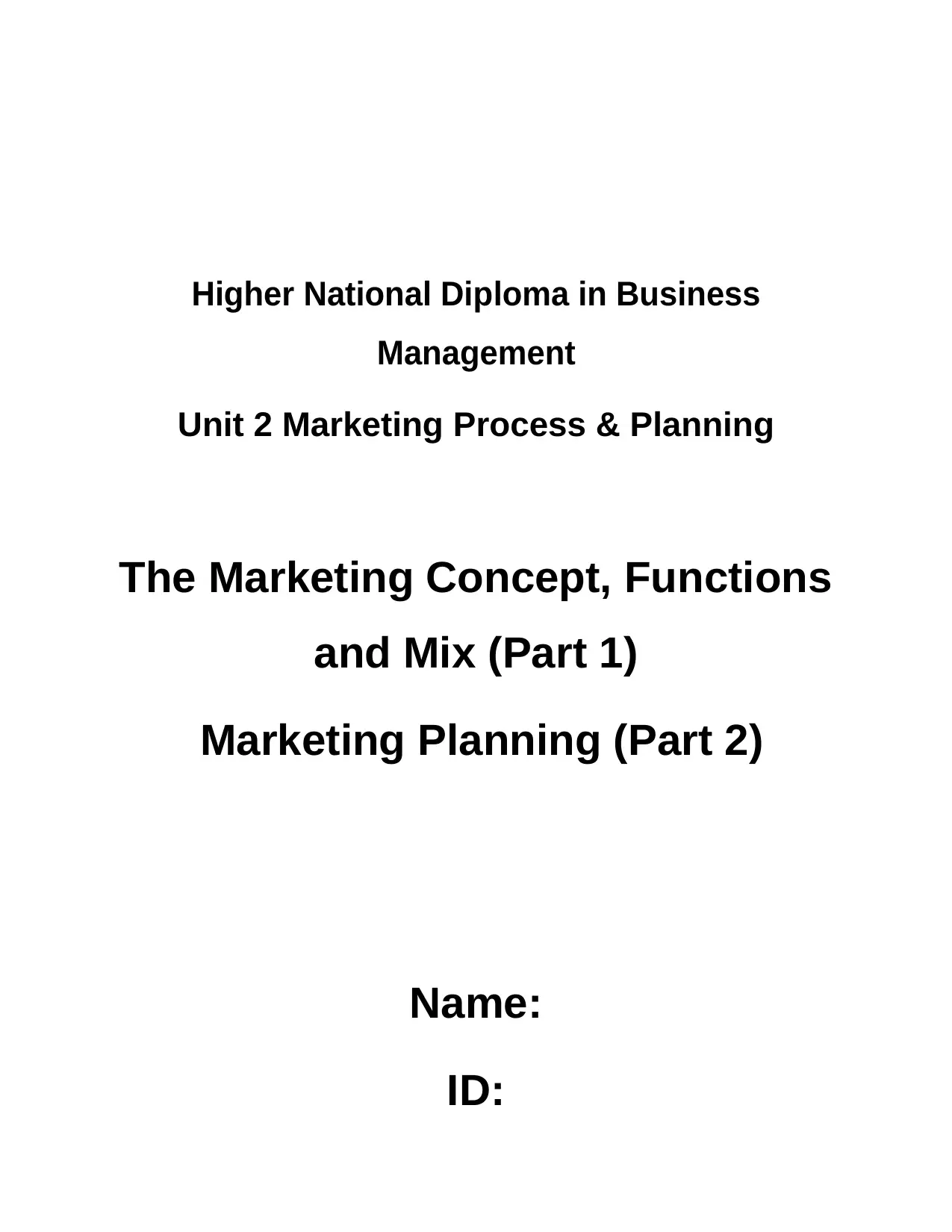
Higher National Diploma in Business
Management
Unit 2 Marketing Process & Planning
The Marketing Concept, Functions
and Mix (Part 1)
Marketing Planning (Part 2)
Name:
ID:
Management
Unit 2 Marketing Process & Planning
The Marketing Concept, Functions
and Mix (Part 1)
Marketing Planning (Part 2)
Name:
ID:
Secure Best Marks with AI Grader
Need help grading? Try our AI Grader for instant feedback on your assignments.

Table of Content
Part 1: Briefing Paper
1.0 Introduction p
2.0 An explanation of the concept/definition of marketing in the 21st century
p
3.0 Description of the role of marketing function with examples from the chosen
organisation p
4.0 An analysis of how the marketing function works and interacts with other
departments p
5.0 An explanation of the extended marketing mix and examples from selected
supermarket p
2.0 An evaluation of how the marketing mix adopted by the selected business
(or business unit) contributes to the success of the organisation in meeting their
overall business objectives p
3.0 Recommendations p
9.0 Conclusions p
References p
Part 1: Briefing Paper
1.0 Introduction p
2.0 An explanation of the concept/definition of marketing in the 21st century
p
3.0 Description of the role of marketing function with examples from the chosen
organisation p
4.0 An analysis of how the marketing function works and interacts with other
departments p
5.0 An explanation of the extended marketing mix and examples from selected
supermarket p
2.0 An evaluation of how the marketing mix adopted by the selected business
(or business unit) contributes to the success of the organisation in meeting their
overall business objectives p
3.0 Recommendations p
9.0 Conclusions p
References p
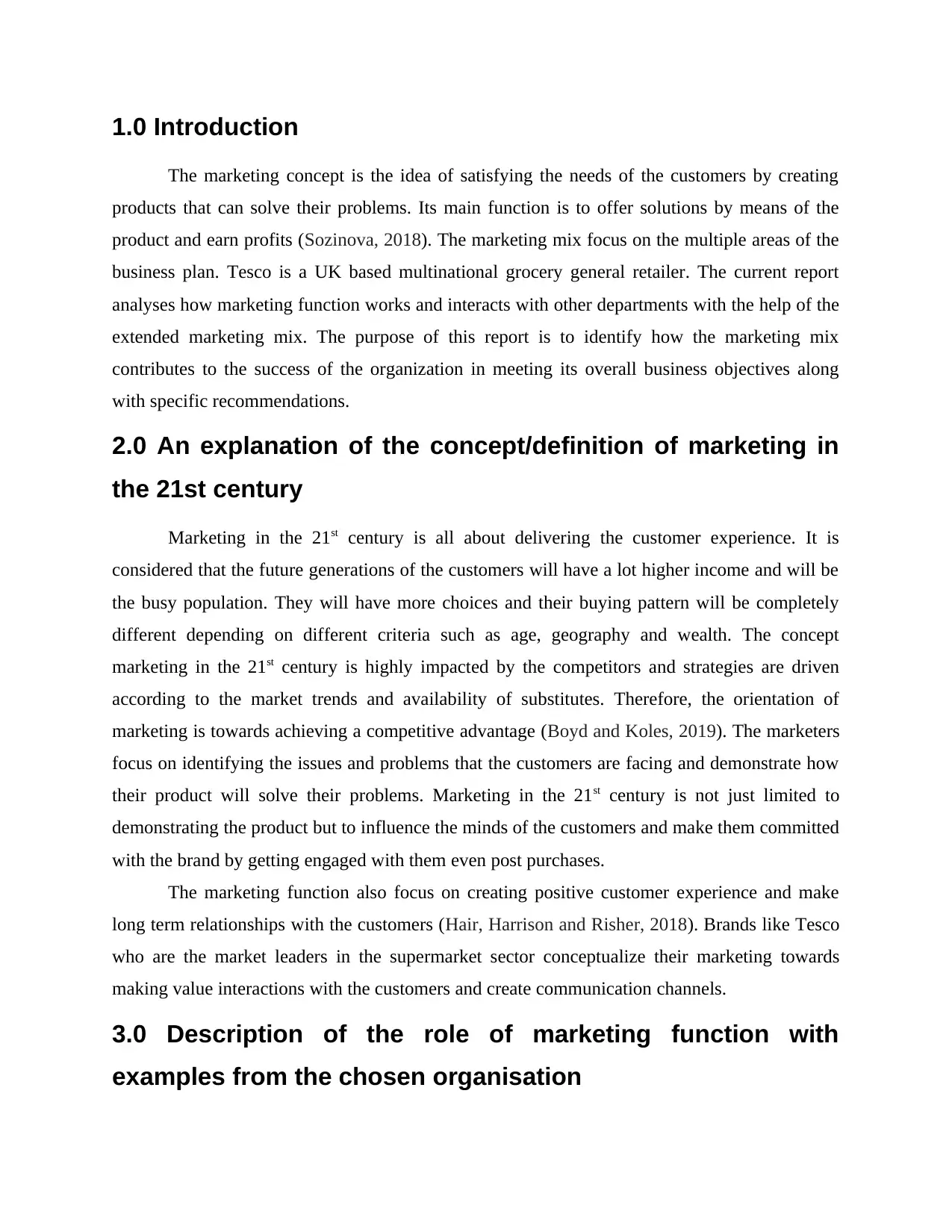
1.0 Introduction
The marketing concept is the idea of satisfying the needs of the customers by creating
products that can solve their problems. Its main function is to offer solutions by means of the
product and earn profits (Sozinova, 2018). The marketing mix focus on the multiple areas of the
business plan. Tesco is a UK based multinational grocery general retailer. The current report
analyses how marketing function works and interacts with other departments with the help of the
extended marketing mix. The purpose of this report is to identify how the marketing mix
contributes to the success of the organization in meeting its overall business objectives along
with specific recommendations.
2.0 An explanation of the concept/definition of marketing in
the 21st century
Marketing in the 21st century is all about delivering the customer experience. It is
considered that the future generations of the customers will have a lot higher income and will be
the busy population. They will have more choices and their buying pattern will be completely
different depending on different criteria such as age, geography and wealth. The concept
marketing in the 21st century is highly impacted by the competitors and strategies are driven
according to the market trends and availability of substitutes. Therefore, the orientation of
marketing is towards achieving a competitive advantage (Boyd and Koles, 2019). The marketers
focus on identifying the issues and problems that the customers are facing and demonstrate how
their product will solve their problems. Marketing in the 21st century is not just limited to
demonstrating the product but to influence the minds of the customers and make them committed
with the brand by getting engaged with them even post purchases.
The marketing function also focus on creating positive customer experience and make
long term relationships with the customers (Hair, Harrison and Risher, 2018). Brands like Tesco
who are the market leaders in the supermarket sector conceptualize their marketing towards
making value interactions with the customers and create communication channels.
3.0 Description of the role of marketing function with
examples from the chosen organisation
The marketing concept is the idea of satisfying the needs of the customers by creating
products that can solve their problems. Its main function is to offer solutions by means of the
product and earn profits (Sozinova, 2018). The marketing mix focus on the multiple areas of the
business plan. Tesco is a UK based multinational grocery general retailer. The current report
analyses how marketing function works and interacts with other departments with the help of the
extended marketing mix. The purpose of this report is to identify how the marketing mix
contributes to the success of the organization in meeting its overall business objectives along
with specific recommendations.
2.0 An explanation of the concept/definition of marketing in
the 21st century
Marketing in the 21st century is all about delivering the customer experience. It is
considered that the future generations of the customers will have a lot higher income and will be
the busy population. They will have more choices and their buying pattern will be completely
different depending on different criteria such as age, geography and wealth. The concept
marketing in the 21st century is highly impacted by the competitors and strategies are driven
according to the market trends and availability of substitutes. Therefore, the orientation of
marketing is towards achieving a competitive advantage (Boyd and Koles, 2019). The marketers
focus on identifying the issues and problems that the customers are facing and demonstrate how
their product will solve their problems. Marketing in the 21st century is not just limited to
demonstrating the product but to influence the minds of the customers and make them committed
with the brand by getting engaged with them even post purchases.
The marketing function also focus on creating positive customer experience and make
long term relationships with the customers (Hair, Harrison and Risher, 2018). Brands like Tesco
who are the market leaders in the supermarket sector conceptualize their marketing towards
making value interactions with the customers and create communication channels.
3.0 Description of the role of marketing function with
examples from the chosen organisation
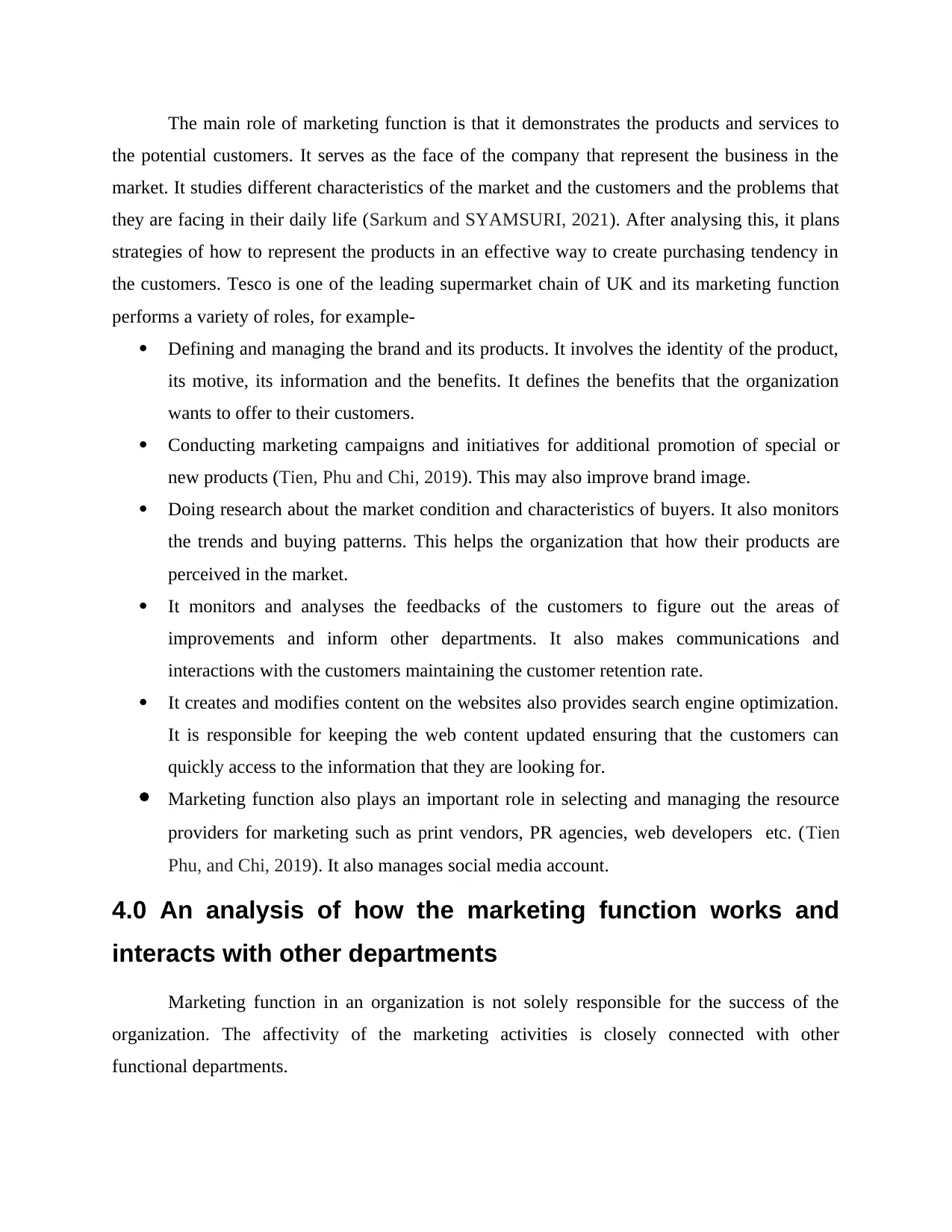
The main role of marketing function is that it demonstrates the products and services to
the potential customers. It serves as the face of the company that represent the business in the
market. It studies different characteristics of the market and the customers and the problems that
they are facing in their daily life (Sarkum and SYAMSURI, 2021). After analysing this, it plans
strategies of how to represent the products in an effective way to create purchasing tendency in
the customers. Tesco is one of the leading supermarket chain of UK and its marketing function
performs a variety of roles, for example-
Defining and managing the brand and its products. It involves the identity of the product,
its motive, its information and the benefits. It defines the benefits that the organization
wants to offer to their customers.
Conducting marketing campaigns and initiatives for additional promotion of special or
new products (Tien, Phu and Chi, 2019). This may also improve brand image.
Doing research about the market condition and characteristics of buyers. It also monitors
the trends and buying patterns. This helps the organization that how their products are
perceived in the market.
It monitors and analyses the feedbacks of the customers to figure out the areas of
improvements and inform other departments. It also makes communications and
interactions with the customers maintaining the customer retention rate.
It creates and modifies content on the websites also provides search engine optimization.
It is responsible for keeping the web content updated ensuring that the customers can
quickly access to the information that they are looking for.
Marketing function also plays an important role in selecting and managing the resource
providers for marketing such as print vendors, PR agencies, web developers etc. (Tien
Phu, and Chi, 2019). It also manages social media account.
4.0 An analysis of how the marketing function works and
interacts with other departments
Marketing function in an organization is not solely responsible for the success of the
organization. The affectivity of the marketing activities is closely connected with other
functional departments.
the potential customers. It serves as the face of the company that represent the business in the
market. It studies different characteristics of the market and the customers and the problems that
they are facing in their daily life (Sarkum and SYAMSURI, 2021). After analysing this, it plans
strategies of how to represent the products in an effective way to create purchasing tendency in
the customers. Tesco is one of the leading supermarket chain of UK and its marketing function
performs a variety of roles, for example-
Defining and managing the brand and its products. It involves the identity of the product,
its motive, its information and the benefits. It defines the benefits that the organization
wants to offer to their customers.
Conducting marketing campaigns and initiatives for additional promotion of special or
new products (Tien, Phu and Chi, 2019). This may also improve brand image.
Doing research about the market condition and characteristics of buyers. It also monitors
the trends and buying patterns. This helps the organization that how their products are
perceived in the market.
It monitors and analyses the feedbacks of the customers to figure out the areas of
improvements and inform other departments. It also makes communications and
interactions with the customers maintaining the customer retention rate.
It creates and modifies content on the websites also provides search engine optimization.
It is responsible for keeping the web content updated ensuring that the customers can
quickly access to the information that they are looking for.
Marketing function also plays an important role in selecting and managing the resource
providers for marketing such as print vendors, PR agencies, web developers etc. (Tien
Phu, and Chi, 2019). It also manages social media account.
4.0 An analysis of how the marketing function works and
interacts with other departments
Marketing function in an organization is not solely responsible for the success of the
organization. The affectivity of the marketing activities is closely connected with other
functional departments.
Secure Best Marks with AI Grader
Need help grading? Try our AI Grader for instant feedback on your assignments.
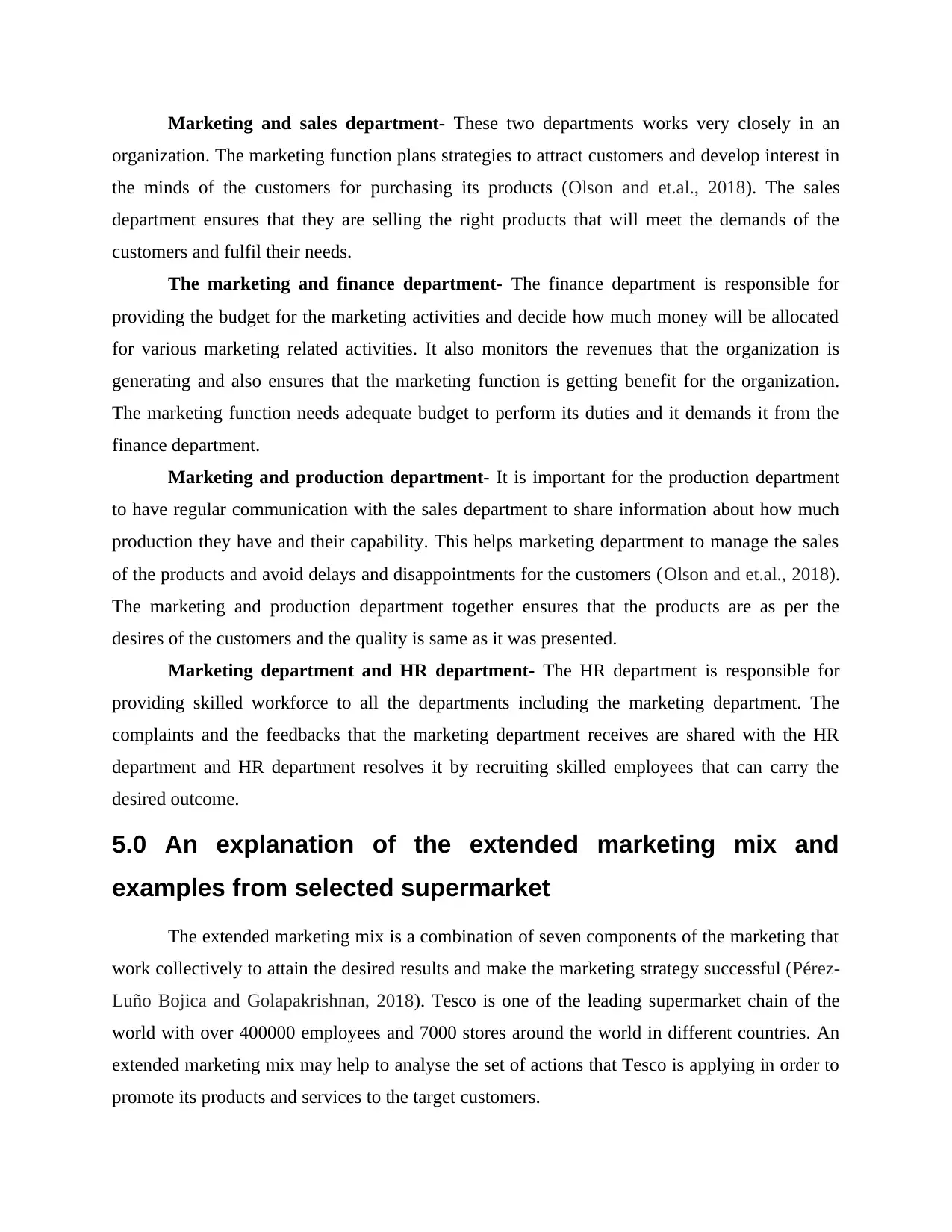
Marketing and sales department- These two departments works very closely in an
organization. The marketing function plans strategies to attract customers and develop interest in
the minds of the customers for purchasing its products (Olson and et.al., 2018). The sales
department ensures that they are selling the right products that will meet the demands of the
customers and fulfil their needs.
The marketing and finance department- The finance department is responsible for
providing the budget for the marketing activities and decide how much money will be allocated
for various marketing related activities. It also monitors the revenues that the organization is
generating and also ensures that the marketing function is getting benefit for the organization.
The marketing function needs adequate budget to perform its duties and it demands it from the
finance department.
Marketing and production department- It is important for the production department
to have regular communication with the sales department to share information about how much
production they have and their capability. This helps marketing department to manage the sales
of the products and avoid delays and disappointments for the customers (Olson and et.al., 2018).
The marketing and production department together ensures that the products are as per the
desires of the customers and the quality is same as it was presented.
Marketing department and HR department- The HR department is responsible for
providing skilled workforce to all the departments including the marketing department. The
complaints and the feedbacks that the marketing department receives are shared with the HR
department and HR department resolves it by recruiting skilled employees that can carry the
desired outcome.
5.0 An explanation of the extended marketing mix and
examples from selected supermarket
The extended marketing mix is a combination of seven components of the marketing that
work collectively to attain the desired results and make the marketing strategy successful (Pérez-
Luño Bojica and Golapakrishnan, 2018). Tesco is one of the leading supermarket chain of the
world with over 400000 employees and 7000 stores around the world in different countries. An
extended marketing mix may help to analyse the set of actions that Tesco is applying in order to
promote its products and services to the target customers.
organization. The marketing function plans strategies to attract customers and develop interest in
the minds of the customers for purchasing its products (Olson and et.al., 2018). The sales
department ensures that they are selling the right products that will meet the demands of the
customers and fulfil their needs.
The marketing and finance department- The finance department is responsible for
providing the budget for the marketing activities and decide how much money will be allocated
for various marketing related activities. It also monitors the revenues that the organization is
generating and also ensures that the marketing function is getting benefit for the organization.
The marketing function needs adequate budget to perform its duties and it demands it from the
finance department.
Marketing and production department- It is important for the production department
to have regular communication with the sales department to share information about how much
production they have and their capability. This helps marketing department to manage the sales
of the products and avoid delays and disappointments for the customers (Olson and et.al., 2018).
The marketing and production department together ensures that the products are as per the
desires of the customers and the quality is same as it was presented.
Marketing department and HR department- The HR department is responsible for
providing skilled workforce to all the departments including the marketing department. The
complaints and the feedbacks that the marketing department receives are shared with the HR
department and HR department resolves it by recruiting skilled employees that can carry the
desired outcome.
5.0 An explanation of the extended marketing mix and
examples from selected supermarket
The extended marketing mix is a combination of seven components of the marketing that
work collectively to attain the desired results and make the marketing strategy successful (Pérez-
Luño Bojica and Golapakrishnan, 2018). Tesco is one of the leading supermarket chain of the
world with over 400000 employees and 7000 stores around the world in different countries. An
extended marketing mix may help to analyse the set of actions that Tesco is applying in order to
promote its products and services to the target customers.
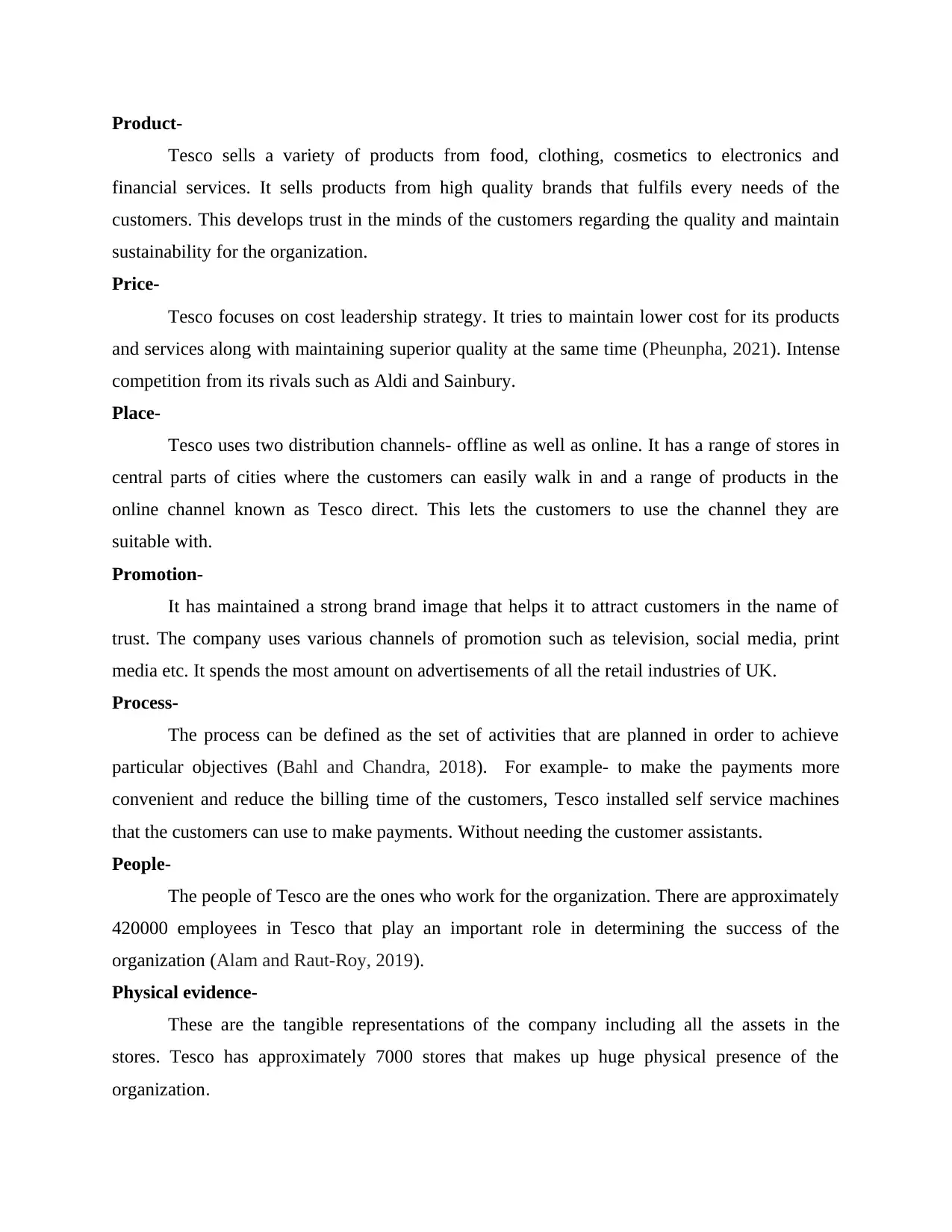
Product-
Tesco sells a variety of products from food, clothing, cosmetics to electronics and
financial services. It sells products from high quality brands that fulfils every needs of the
customers. This develops trust in the minds of the customers regarding the quality and maintain
sustainability for the organization.
Price-
Tesco focuses on cost leadership strategy. It tries to maintain lower cost for its products
and services along with maintaining superior quality at the same time (Pheunpha, 2021). Intense
competition from its rivals such as Aldi and Sainbury.
Place-
Tesco uses two distribution channels- offline as well as online. It has a range of stores in
central parts of cities where the customers can easily walk in and a range of products in the
online channel known as Tesco direct. This lets the customers to use the channel they are
suitable with.
Promotion-
It has maintained a strong brand image that helps it to attract customers in the name of
trust. The company uses various channels of promotion such as television, social media, print
media etc. It spends the most amount on advertisements of all the retail industries of UK.
Process-
The process can be defined as the set of activities that are planned in order to achieve
particular objectives (Bahl and Chandra, 2018). For example- to make the payments more
convenient and reduce the billing time of the customers, Tesco installed self service machines
that the customers can use to make payments. Without needing the customer assistants.
People-
The people of Tesco are the ones who work for the organization. There are approximately
420000 employees in Tesco that play an important role in determining the success of the
organization (Alam and Raut-Roy, 2019).
Physical evidence-
These are the tangible representations of the company including all the assets in the
stores. Tesco has approximately 7000 stores that makes up huge physical presence of the
organization.
Tesco sells a variety of products from food, clothing, cosmetics to electronics and
financial services. It sells products from high quality brands that fulfils every needs of the
customers. This develops trust in the minds of the customers regarding the quality and maintain
sustainability for the organization.
Price-
Tesco focuses on cost leadership strategy. It tries to maintain lower cost for its products
and services along with maintaining superior quality at the same time (Pheunpha, 2021). Intense
competition from its rivals such as Aldi and Sainbury.
Place-
Tesco uses two distribution channels- offline as well as online. It has a range of stores in
central parts of cities where the customers can easily walk in and a range of products in the
online channel known as Tesco direct. This lets the customers to use the channel they are
suitable with.
Promotion-
It has maintained a strong brand image that helps it to attract customers in the name of
trust. The company uses various channels of promotion such as television, social media, print
media etc. It spends the most amount on advertisements of all the retail industries of UK.
Process-
The process can be defined as the set of activities that are planned in order to achieve
particular objectives (Bahl and Chandra, 2018). For example- to make the payments more
convenient and reduce the billing time of the customers, Tesco installed self service machines
that the customers can use to make payments. Without needing the customer assistants.
People-
The people of Tesco are the ones who work for the organization. There are approximately
420000 employees in Tesco that play an important role in determining the success of the
organization (Alam and Raut-Roy, 2019).
Physical evidence-
These are the tangible representations of the company including all the assets in the
stores. Tesco has approximately 7000 stores that makes up huge physical presence of the
organization.
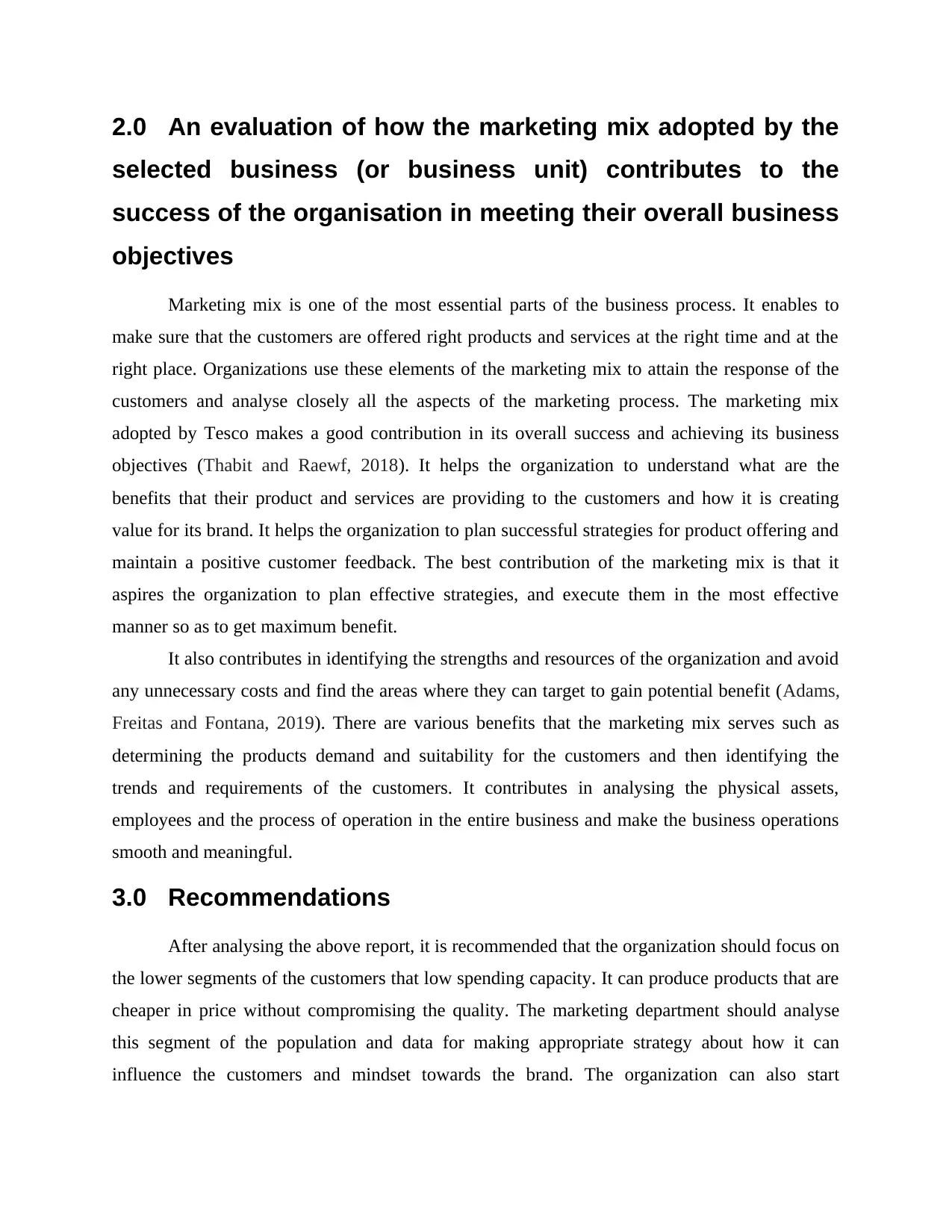
2.0 An evaluation of how the marketing mix adopted by the
selected business (or business unit) contributes to the
success of the organisation in meeting their overall business
objectives
Marketing mix is one of the most essential parts of the business process. It enables to
make sure that the customers are offered right products and services at the right time and at the
right place. Organizations use these elements of the marketing mix to attain the response of the
customers and analyse closely all the aspects of the marketing process. The marketing mix
adopted by Tesco makes a good contribution in its overall success and achieving its business
objectives (Thabit and Raewf, 2018). It helps the organization to understand what are the
benefits that their product and services are providing to the customers and how it is creating
value for its brand. It helps the organization to plan successful strategies for product offering and
maintain a positive customer feedback. The best contribution of the marketing mix is that it
aspires the organization to plan effective strategies, and execute them in the most effective
manner so as to get maximum benefit.
It also contributes in identifying the strengths and resources of the organization and avoid
any unnecessary costs and find the areas where they can target to gain potential benefit (Adams,
Freitas and Fontana, 2019). There are various benefits that the marketing mix serves such as
determining the products demand and suitability for the customers and then identifying the
trends and requirements of the customers. It contributes in analysing the physical assets,
employees and the process of operation in the entire business and make the business operations
smooth and meaningful.
3.0 Recommendations
After analysing the above report, it is recommended that the organization should focus on
the lower segments of the customers that low spending capacity. It can produce products that are
cheaper in price without compromising the quality. The marketing department should analyse
this segment of the population and data for making appropriate strategy about how it can
influence the customers and mindset towards the brand. The organization can also start
selected business (or business unit) contributes to the
success of the organisation in meeting their overall business
objectives
Marketing mix is one of the most essential parts of the business process. It enables to
make sure that the customers are offered right products and services at the right time and at the
right place. Organizations use these elements of the marketing mix to attain the response of the
customers and analyse closely all the aspects of the marketing process. The marketing mix
adopted by Tesco makes a good contribution in its overall success and achieving its business
objectives (Thabit and Raewf, 2018). It helps the organization to understand what are the
benefits that their product and services are providing to the customers and how it is creating
value for its brand. It helps the organization to plan successful strategies for product offering and
maintain a positive customer feedback. The best contribution of the marketing mix is that it
aspires the organization to plan effective strategies, and execute them in the most effective
manner so as to get maximum benefit.
It also contributes in identifying the strengths and resources of the organization and avoid
any unnecessary costs and find the areas where they can target to gain potential benefit (Adams,
Freitas and Fontana, 2019). There are various benefits that the marketing mix serves such as
determining the products demand and suitability for the customers and then identifying the
trends and requirements of the customers. It contributes in analysing the physical assets,
employees and the process of operation in the entire business and make the business operations
smooth and meaningful.
3.0 Recommendations
After analysing the above report, it is recommended that the organization should focus on
the lower segments of the customers that low spending capacity. It can produce products that are
cheaper in price without compromising the quality. The marketing department should analyse
this segment of the population and data for making appropriate strategy about how it can
influence the customers and mindset towards the brand. The organization can also start
Paraphrase This Document
Need a fresh take? Get an instant paraphrase of this document with our AI Paraphraser
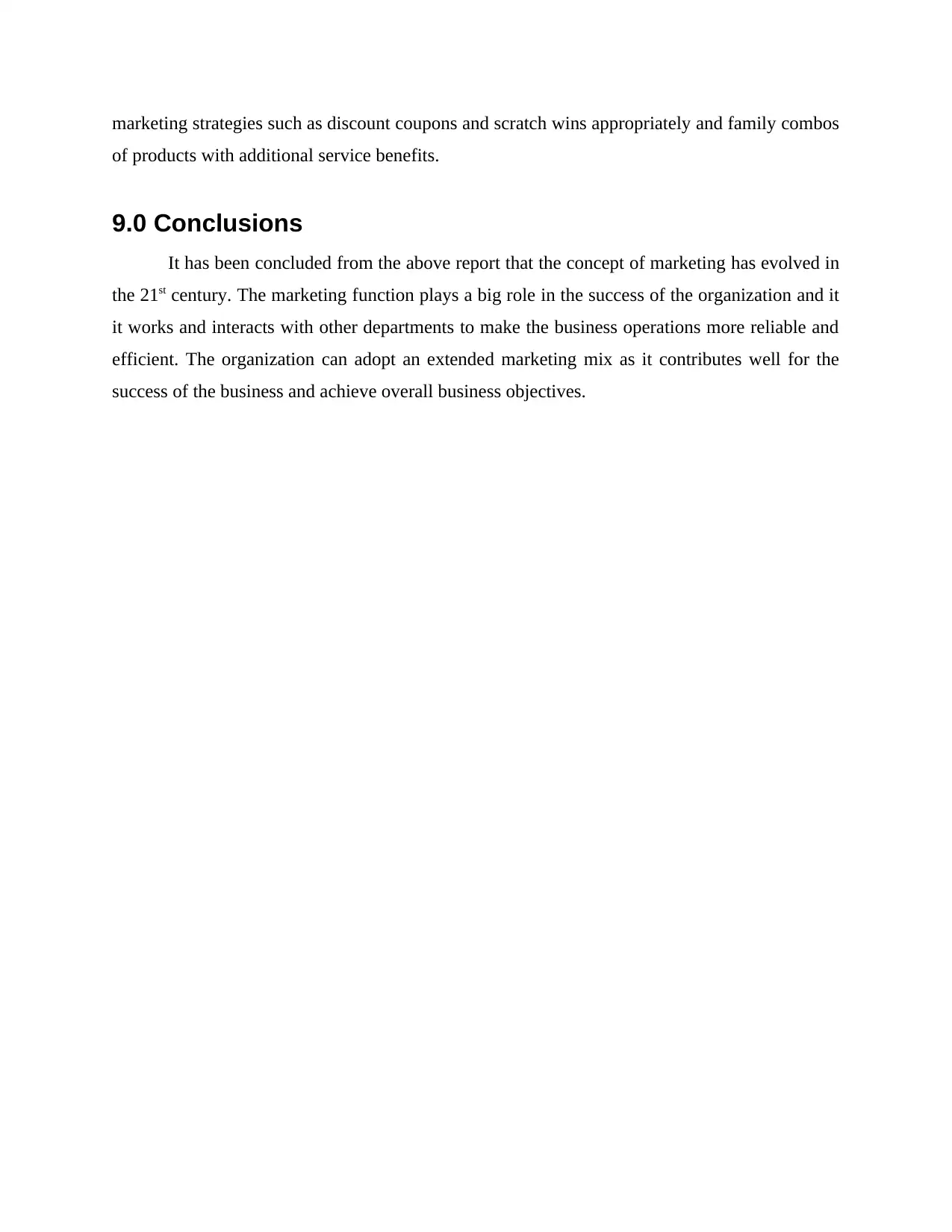
marketing strategies such as discount coupons and scratch wins appropriately and family combos
of products with additional service benefits.
9.0 Conclusions
It has been concluded from the above report that the concept of marketing has evolved in
the 21st century. The marketing function plays a big role in the success of the organization and it
it works and interacts with other departments to make the business operations more reliable and
efficient. The organization can adopt an extended marketing mix as it contributes well for the
success of the business and achieve overall business objectives.
of products with additional service benefits.
9.0 Conclusions
It has been concluded from the above report that the concept of marketing has evolved in
the 21st century. The marketing function plays a big role in the success of the organization and it
it works and interacts with other departments to make the business operations more reliable and
efficient. The organization can adopt an extended marketing mix as it contributes well for the
success of the business and achieve overall business objectives.
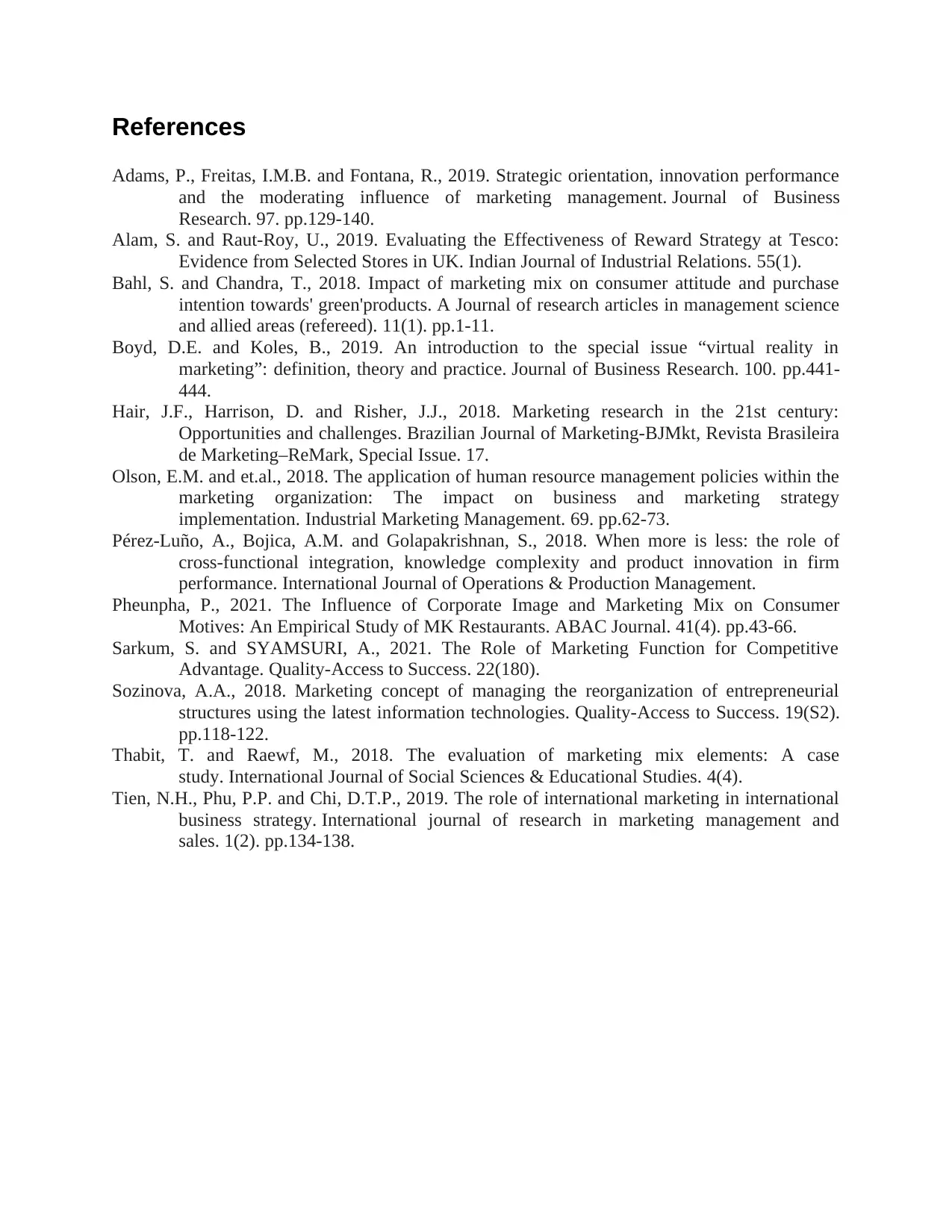
References
Adams, P., Freitas, I.M.B. and Fontana, R., 2019. Strategic orientation, innovation performance
and the moderating influence of marketing management. Journal of Business
Research. 97. pp.129-140.
Alam, S. and Raut-Roy, U., 2019. Evaluating the Effectiveness of Reward Strategy at Tesco:
Evidence from Selected Stores in UK. Indian Journal of Industrial Relations. 55(1).
Bahl, S. and Chandra, T., 2018. Impact of marketing mix on consumer attitude and purchase
intention towards' green'products. A Journal of research articles in management science
and allied areas (refereed). 11(1). pp.1-11.
Boyd, D.E. and Koles, B., 2019. An introduction to the special issue “virtual reality in
marketing”: definition, theory and practice. Journal of Business Research. 100. pp.441-
444.
Hair, J.F., Harrison, D. and Risher, J.J., 2018. Marketing research in the 21st century:
Opportunities and challenges. Brazilian Journal of Marketing-BJMkt, Revista Brasileira
de Marketing–ReMark, Special Issue. 17.
Olson, E.M. and et.al., 2018. The application of human resource management policies within the
marketing organization: The impact on business and marketing strategy
implementation. Industrial Marketing Management. 69. pp.62-73.
Pérez-Luño, A., Bojica, A.M. and Golapakrishnan, S., 2018. When more is less: the role of
cross-functional integration, knowledge complexity and product innovation in firm
performance. International Journal of Operations & Production Management.
Pheunpha, P., 2021. The Influence of Corporate Image and Marketing Mix on Consumer
Motives: An Empirical Study of MK Restaurants. ABAC Journal. 41(4). pp.43-66.
Sarkum, S. and SYAMSURI, A., 2021. The Role of Marketing Function for Competitive
Advantage. Quality-Access to Success. 22(180).
Sozinova, A.A., 2018. Marketing concept of managing the reorganization of entrepreneurial
structures using the latest information technologies. Quality-Access to Success. 19(S2).
pp.118-122.
Thabit, T. and Raewf, M., 2018. The evaluation of marketing mix elements: A case
study. International Journal of Social Sciences & Educational Studies. 4(4).
Tien, N.H., Phu, P.P. and Chi, D.T.P., 2019. The role of international marketing in international
business strategy. International journal of research in marketing management and
sales. 1(2). pp.134-138.
Adams, P., Freitas, I.M.B. and Fontana, R., 2019. Strategic orientation, innovation performance
and the moderating influence of marketing management. Journal of Business
Research. 97. pp.129-140.
Alam, S. and Raut-Roy, U., 2019. Evaluating the Effectiveness of Reward Strategy at Tesco:
Evidence from Selected Stores in UK. Indian Journal of Industrial Relations. 55(1).
Bahl, S. and Chandra, T., 2018. Impact of marketing mix on consumer attitude and purchase
intention towards' green'products. A Journal of research articles in management science
and allied areas (refereed). 11(1). pp.1-11.
Boyd, D.E. and Koles, B., 2019. An introduction to the special issue “virtual reality in
marketing”: definition, theory and practice. Journal of Business Research. 100. pp.441-
444.
Hair, J.F., Harrison, D. and Risher, J.J., 2018. Marketing research in the 21st century:
Opportunities and challenges. Brazilian Journal of Marketing-BJMkt, Revista Brasileira
de Marketing–ReMark, Special Issue. 17.
Olson, E.M. and et.al., 2018. The application of human resource management policies within the
marketing organization: The impact on business and marketing strategy
implementation. Industrial Marketing Management. 69. pp.62-73.
Pérez-Luño, A., Bojica, A.M. and Golapakrishnan, S., 2018. When more is less: the role of
cross-functional integration, knowledge complexity and product innovation in firm
performance. International Journal of Operations & Production Management.
Pheunpha, P., 2021. The Influence of Corporate Image and Marketing Mix on Consumer
Motives: An Empirical Study of MK Restaurants. ABAC Journal. 41(4). pp.43-66.
Sarkum, S. and SYAMSURI, A., 2021. The Role of Marketing Function for Competitive
Advantage. Quality-Access to Success. 22(180).
Sozinova, A.A., 2018. Marketing concept of managing the reorganization of entrepreneurial
structures using the latest information technologies. Quality-Access to Success. 19(S2).
pp.118-122.
Thabit, T. and Raewf, M., 2018. The evaluation of marketing mix elements: A case
study. International Journal of Social Sciences & Educational Studies. 4(4).
Tien, N.H., Phu, P.P. and Chi, D.T.P., 2019. The role of international marketing in international
business strategy. International journal of research in marketing management and
sales. 1(2). pp.134-138.

Secure Best Marks with AI Grader
Need help grading? Try our AI Grader for instant feedback on your assignments.
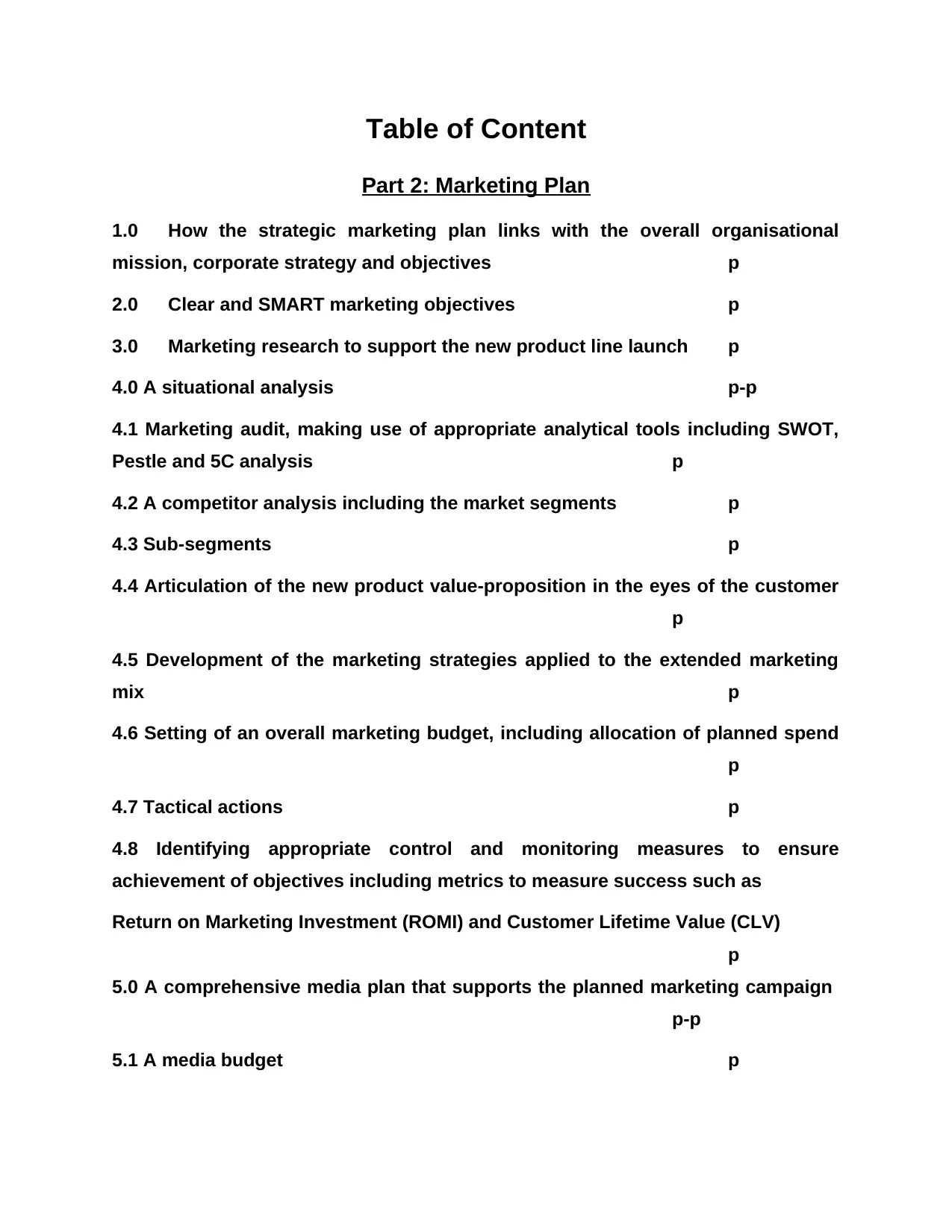
Table of Content
Part 2: Marketing Plan
1.0 How the strategic marketing plan links with the overall organisational
mission, corporate strategy and objectives p
2.0 Clear and SMART marketing objectives p
3.0 Marketing research to support the new product line launch p
4.0 A situational analysis p-p
4.1 Marketing audit, making use of appropriate analytical tools including SWOT,
Pestle and 5C analysis p
4.2 A competitor analysis including the market segments p
4.3 Sub-segments p
4.4 Articulation of the new product value-proposition in the eyes of the customer
p
4.5 Development of the marketing strategies applied to the extended marketing
mix p
4.6 Setting of an overall marketing budget, including allocation of planned spend
p
4.7 Tactical actions p
4.8 Identifying appropriate control and monitoring measures to ensure
achievement of objectives including metrics to measure success such as
Return on Marketing Investment (ROMI) and Customer Lifetime Value (CLV)
p
5.0 A comprehensive media plan that supports the planned marketing campaign
p-p
5.1 A media budget p
Part 2: Marketing Plan
1.0 How the strategic marketing plan links with the overall organisational
mission, corporate strategy and objectives p
2.0 Clear and SMART marketing objectives p
3.0 Marketing research to support the new product line launch p
4.0 A situational analysis p-p
4.1 Marketing audit, making use of appropriate analytical tools including SWOT,
Pestle and 5C analysis p
4.2 A competitor analysis including the market segments p
4.3 Sub-segments p
4.4 Articulation of the new product value-proposition in the eyes of the customer
p
4.5 Development of the marketing strategies applied to the extended marketing
mix p
4.6 Setting of an overall marketing budget, including allocation of planned spend
p
4.7 Tactical actions p
4.8 Identifying appropriate control and monitoring measures to ensure
achievement of objectives including metrics to measure success such as
Return on Marketing Investment (ROMI) and Customer Lifetime Value (CLV)
p
5.0 A comprehensive media plan that supports the planned marketing campaign
p-p
5.1 A media budget p
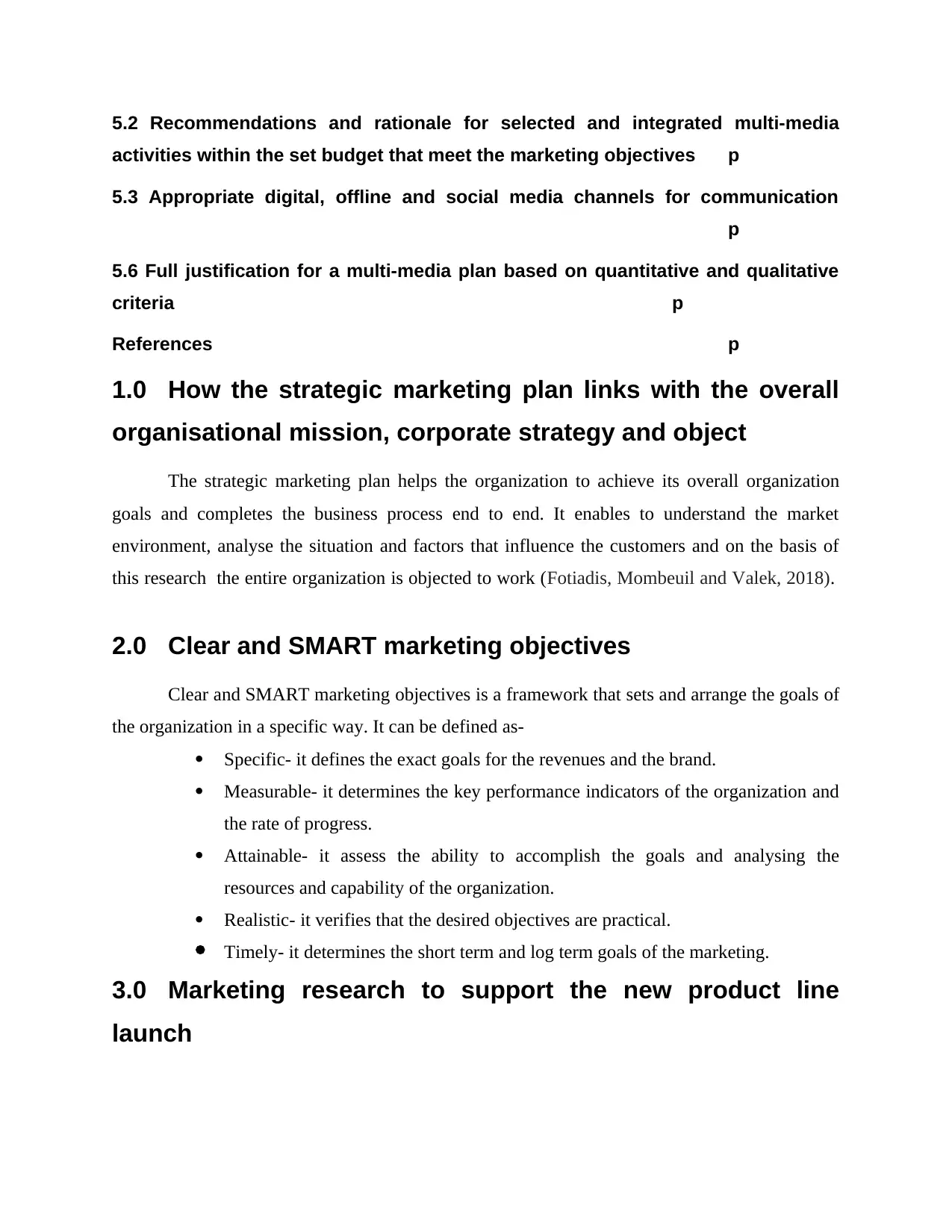
5.2 Recommendations and rationale for selected and integrated multi-media
activities within the set budget that meet the marketing objectives p
5.3 Appropriate digital, offline and social media channels for communication
p
5.6 Full justification for a multi-media plan based on quantitative and qualitative
criteria p
References p
1.0 How the strategic marketing plan links with the overall
organisational mission, corporate strategy and object
The strategic marketing plan helps the organization to achieve its overall organization
goals and completes the business process end to end. It enables to understand the market
environment, analyse the situation and factors that influence the customers and on the basis of
this research the entire organization is objected to work (Fotiadis, Mombeuil and Valek, 2018).
2.0 Clear and SMART marketing objectives
Clear and SMART marketing objectives is a framework that sets and arrange the goals of
the organization in a specific way. It can be defined as-
Specific- it defines the exact goals for the revenues and the brand.
Measurable- it determines the key performance indicators of the organization and
the rate of progress.
Attainable- it assess the ability to accomplish the goals and analysing the
resources and capability of the organization.
Realistic- it verifies that the desired objectives are practical.
Timely- it determines the short term and log term goals of the marketing.
3.0 Marketing research to support the new product line
launch
activities within the set budget that meet the marketing objectives p
5.3 Appropriate digital, offline and social media channels for communication
p
5.6 Full justification for a multi-media plan based on quantitative and qualitative
criteria p
References p
1.0 How the strategic marketing plan links with the overall
organisational mission, corporate strategy and object
The strategic marketing plan helps the organization to achieve its overall organization
goals and completes the business process end to end. It enables to understand the market
environment, analyse the situation and factors that influence the customers and on the basis of
this research the entire organization is objected to work (Fotiadis, Mombeuil and Valek, 2018).
2.0 Clear and SMART marketing objectives
Clear and SMART marketing objectives is a framework that sets and arrange the goals of
the organization in a specific way. It can be defined as-
Specific- it defines the exact goals for the revenues and the brand.
Measurable- it determines the key performance indicators of the organization and
the rate of progress.
Attainable- it assess the ability to accomplish the goals and analysing the
resources and capability of the organization.
Realistic- it verifies that the desired objectives are practical.
Timely- it determines the short term and log term goals of the marketing.
3.0 Marketing research to support the new product line
launch
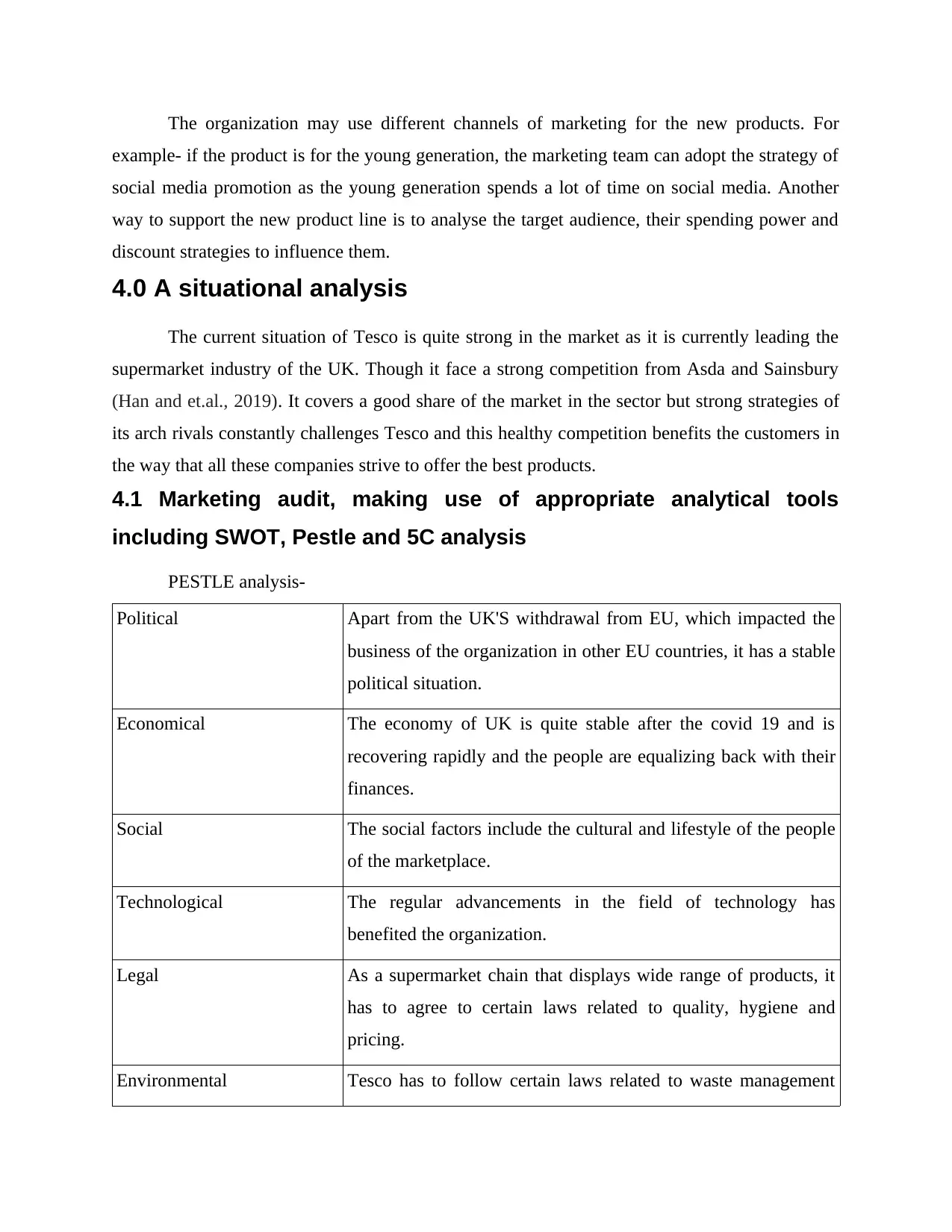
The organization may use different channels of marketing for the new products. For
example- if the product is for the young generation, the marketing team can adopt the strategy of
social media promotion as the young generation spends a lot of time on social media. Another
way to support the new product line is to analyse the target audience, their spending power and
discount strategies to influence them.
4.0 A situational analysis
The current situation of Tesco is quite strong in the market as it is currently leading the
supermarket industry of the UK. Though it face a strong competition from Asda and Sainsbury
(Han and et.al., 2019). It covers a good share of the market in the sector but strong strategies of
its arch rivals constantly challenges Tesco and this healthy competition benefits the customers in
the way that all these companies strive to offer the best products.
4.1 Marketing audit, making use of appropriate analytical tools
including SWOT, Pestle and 5C analysis
PESTLE analysis-
Political Apart from the UK'S withdrawal from EU, which impacted the
business of the organization in other EU countries, it has a stable
political situation.
Economical The economy of UK is quite stable after the covid 19 and is
recovering rapidly and the people are equalizing back with their
finances.
Social The social factors include the cultural and lifestyle of the people
of the marketplace.
Technological The regular advancements in the field of technology has
benefited the organization.
Legal As a supermarket chain that displays wide range of products, it
has to agree to certain laws related to quality, hygiene and
pricing.
Environmental Tesco has to follow certain laws related to waste management
example- if the product is for the young generation, the marketing team can adopt the strategy of
social media promotion as the young generation spends a lot of time on social media. Another
way to support the new product line is to analyse the target audience, their spending power and
discount strategies to influence them.
4.0 A situational analysis
The current situation of Tesco is quite strong in the market as it is currently leading the
supermarket industry of the UK. Though it face a strong competition from Asda and Sainsbury
(Han and et.al., 2019). It covers a good share of the market in the sector but strong strategies of
its arch rivals constantly challenges Tesco and this healthy competition benefits the customers in
the way that all these companies strive to offer the best products.
4.1 Marketing audit, making use of appropriate analytical tools
including SWOT, Pestle and 5C analysis
PESTLE analysis-
Political Apart from the UK'S withdrawal from EU, which impacted the
business of the organization in other EU countries, it has a stable
political situation.
Economical The economy of UK is quite stable after the covid 19 and is
recovering rapidly and the people are equalizing back with their
finances.
Social The social factors include the cultural and lifestyle of the people
of the marketplace.
Technological The regular advancements in the field of technology has
benefited the organization.
Legal As a supermarket chain that displays wide range of products, it
has to agree to certain laws related to quality, hygiene and
pricing.
Environmental Tesco has to follow certain laws related to waste management
Paraphrase This Document
Need a fresh take? Get an instant paraphrase of this document with our AI Paraphraser
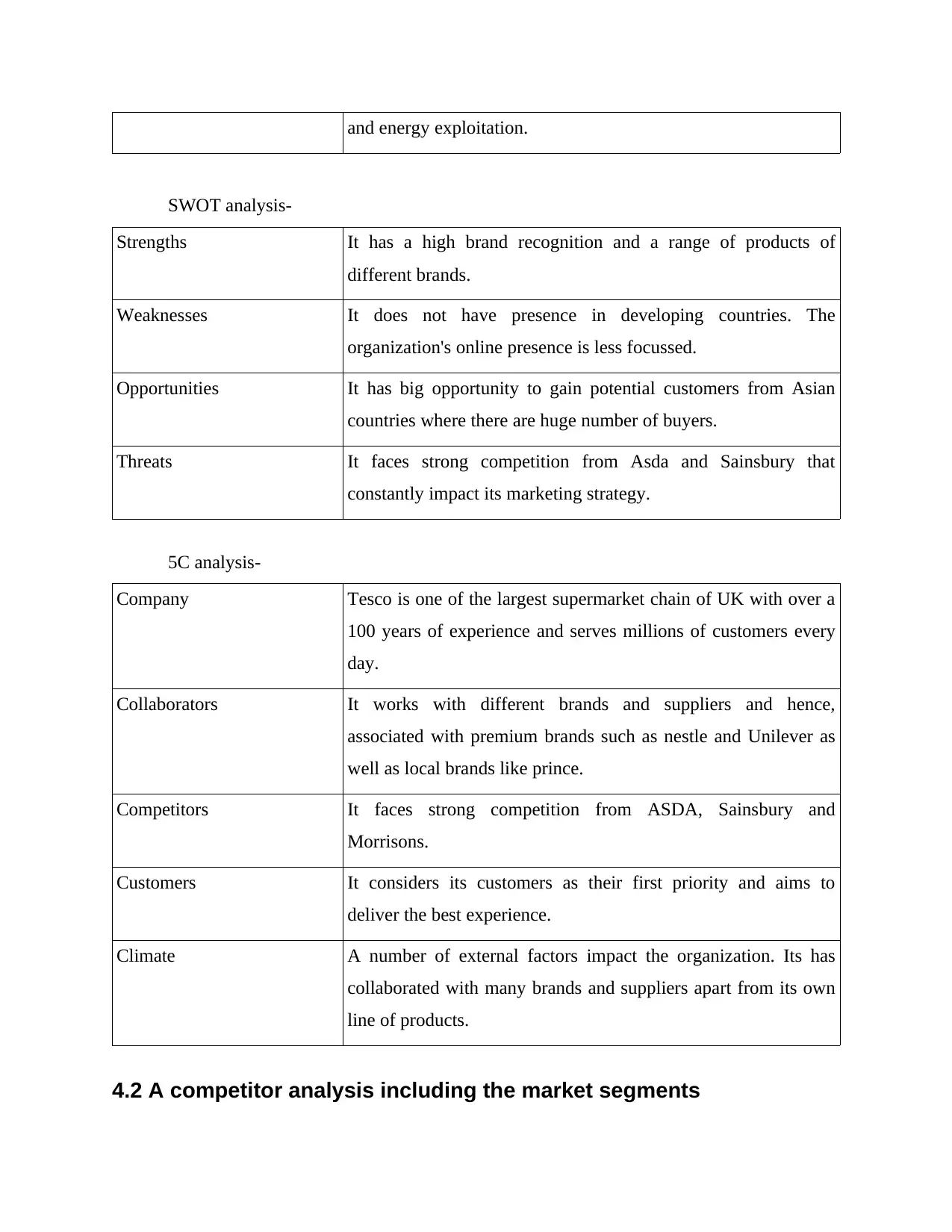
and energy exploitation.
SWOT analysis-
Strengths It has a high brand recognition and a range of products of
different brands.
Weaknesses It does not have presence in developing countries. The
organization's online presence is less focussed.
Opportunities It has big opportunity to gain potential customers from Asian
countries where there are huge number of buyers.
Threats It faces strong competition from Asda and Sainsbury that
constantly impact its marketing strategy.
5C analysis-
Company Tesco is one of the largest supermarket chain of UK with over a
100 years of experience and serves millions of customers every
day.
Collaborators It works with different brands and suppliers and hence,
associated with premium brands such as nestle and Unilever as
well as local brands like prince.
Competitors It faces strong competition from ASDA, Sainsbury and
Morrisons.
Customers It considers its customers as their first priority and aims to
deliver the best experience.
Climate A number of external factors impact the organization. Its has
collaborated with many brands and suppliers apart from its own
line of products.
4.2 A competitor analysis including the market segments
SWOT analysis-
Strengths It has a high brand recognition and a range of products of
different brands.
Weaknesses It does not have presence in developing countries. The
organization's online presence is less focussed.
Opportunities It has big opportunity to gain potential customers from Asian
countries where there are huge number of buyers.
Threats It faces strong competition from Asda and Sainsbury that
constantly impact its marketing strategy.
5C analysis-
Company Tesco is one of the largest supermarket chain of UK with over a
100 years of experience and serves millions of customers every
day.
Collaborators It works with different brands and suppliers and hence,
associated with premium brands such as nestle and Unilever as
well as local brands like prince.
Competitors It faces strong competition from ASDA, Sainsbury and
Morrisons.
Customers It considers its customers as their first priority and aims to
deliver the best experience.
Climate A number of external factors impact the organization. Its has
collaborated with many brands and suppliers apart from its own
line of products.
4.2 A competitor analysis including the market segments
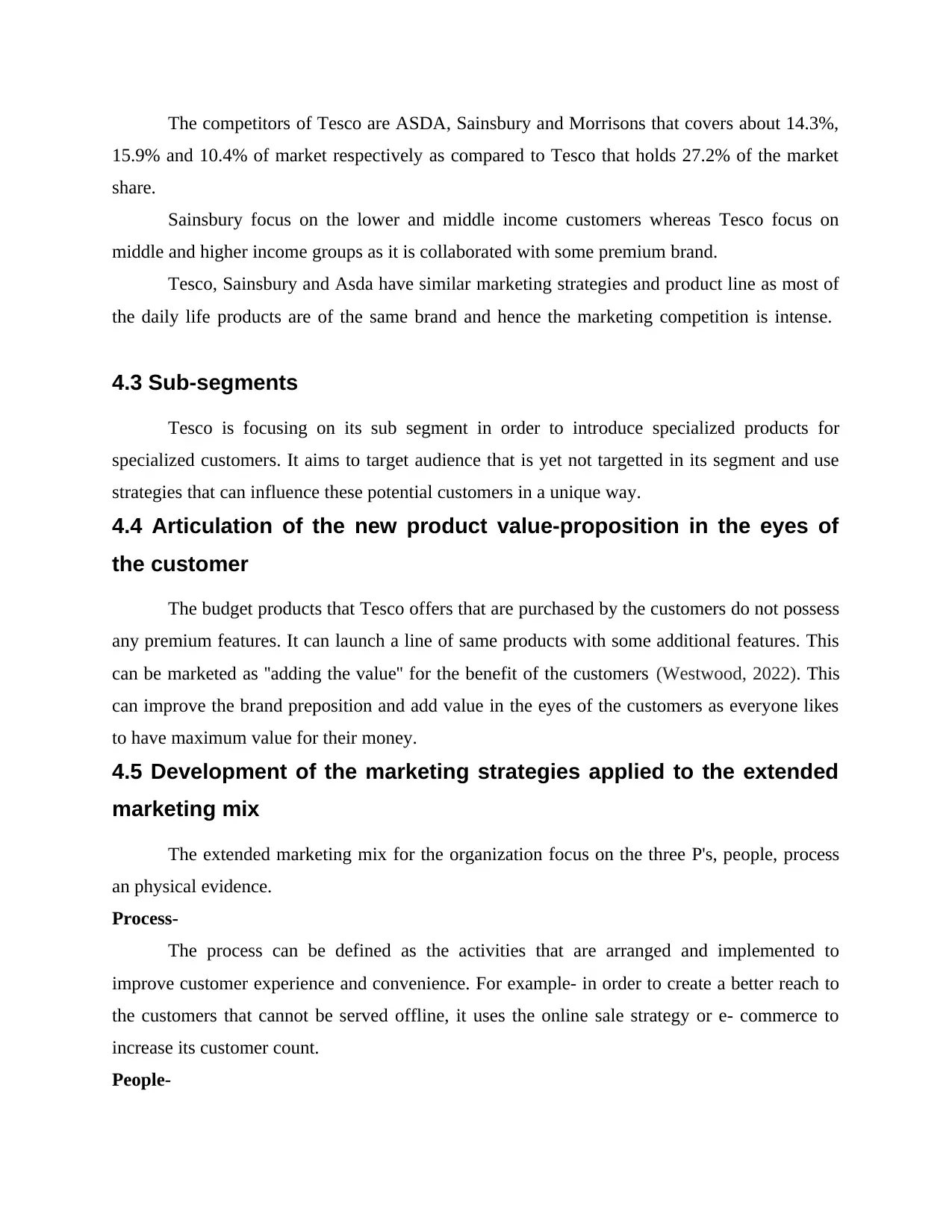
The competitors of Tesco are ASDA, Sainsbury and Morrisons that covers about 14.3%,
15.9% and 10.4% of market respectively as compared to Tesco that holds 27.2% of the market
share.
Sainsbury focus on the lower and middle income customers whereas Tesco focus on
middle and higher income groups as it is collaborated with some premium brand.
Tesco, Sainsbury and Asda have similar marketing strategies and product line as most of
the daily life products are of the same brand and hence the marketing competition is intense.
4.3 Sub-segments
Tesco is focusing on its sub segment in order to introduce specialized products for
specialized customers. It aims to target audience that is yet not targetted in its segment and use
strategies that can influence these potential customers in a unique way.
4.4 Articulation of the new product value-proposition in the eyes of
the customer
The budget products that Tesco offers that are purchased by the customers do not possess
any premium features. It can launch a line of same products with some additional features. This
can be marketed as ''adding the value'' for the benefit of the customers (Westwood, 2022). This
can improve the brand preposition and add value in the eyes of the customers as everyone likes
to have maximum value for their money.
4.5 Development of the marketing strategies applied to the extended
marketing mix
The extended marketing mix for the organization focus on the three P's, people, process
an physical evidence.
Process-
The process can be defined as the activities that are arranged and implemented to
improve customer experience and convenience. For example- in order to create a better reach to
the customers that cannot be served offline, it uses the online sale strategy or e- commerce to
increase its customer count.
People-
15.9% and 10.4% of market respectively as compared to Tesco that holds 27.2% of the market
share.
Sainsbury focus on the lower and middle income customers whereas Tesco focus on
middle and higher income groups as it is collaborated with some premium brand.
Tesco, Sainsbury and Asda have similar marketing strategies and product line as most of
the daily life products are of the same brand and hence the marketing competition is intense.
4.3 Sub-segments
Tesco is focusing on its sub segment in order to introduce specialized products for
specialized customers. It aims to target audience that is yet not targetted in its segment and use
strategies that can influence these potential customers in a unique way.
4.4 Articulation of the new product value-proposition in the eyes of
the customer
The budget products that Tesco offers that are purchased by the customers do not possess
any premium features. It can launch a line of same products with some additional features. This
can be marketed as ''adding the value'' for the benefit of the customers (Westwood, 2022). This
can improve the brand preposition and add value in the eyes of the customers as everyone likes
to have maximum value for their money.
4.5 Development of the marketing strategies applied to the extended
marketing mix
The extended marketing mix for the organization focus on the three P's, people, process
an physical evidence.
Process-
The process can be defined as the activities that are arranged and implemented to
improve customer experience and convenience. For example- in order to create a better reach to
the customers that cannot be served offline, it uses the online sale strategy or e- commerce to
increase its customer count.
People-
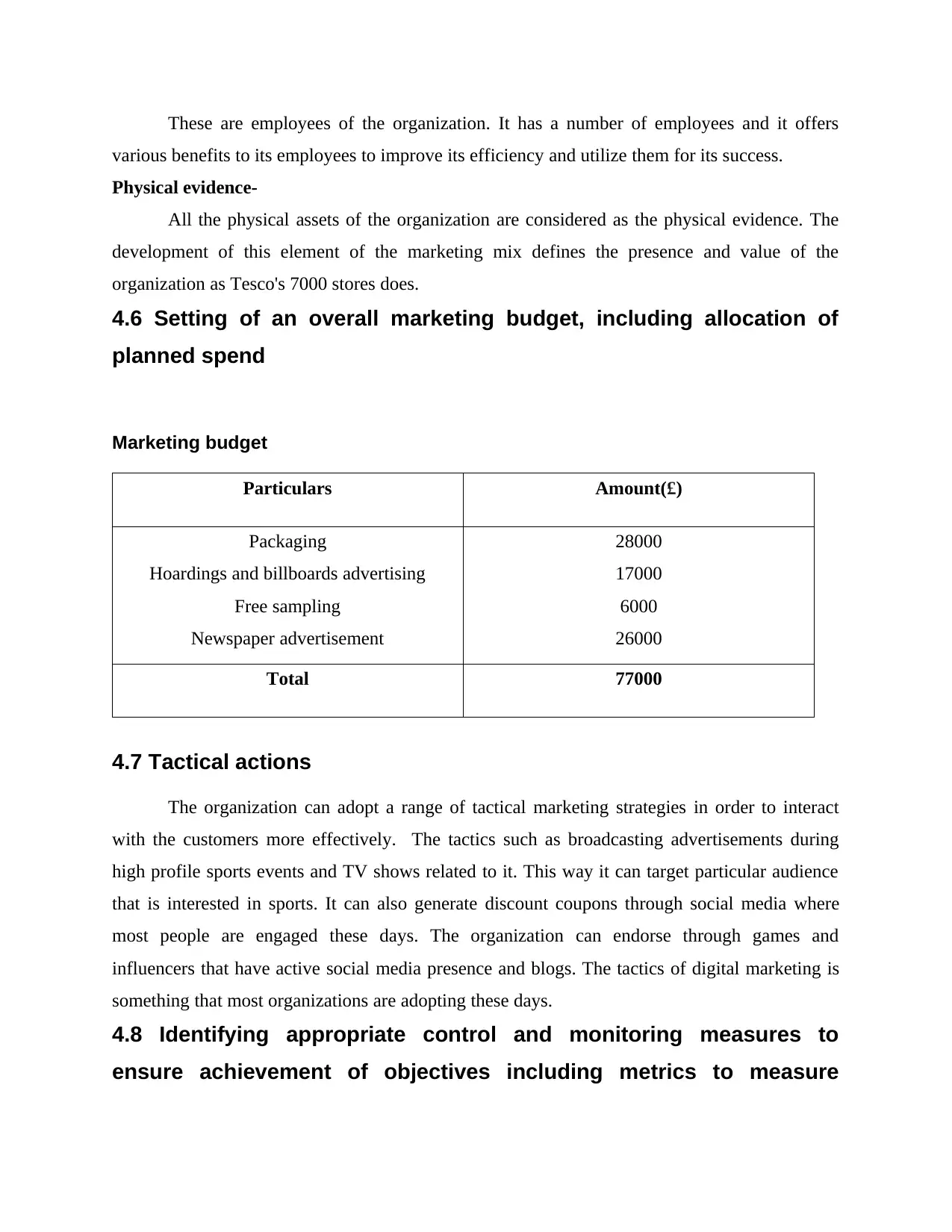
These are employees of the organization. It has a number of employees and it offers
various benefits to its employees to improve its efficiency and utilize them for its success.
Physical evidence-
All the physical assets of the organization are considered as the physical evidence. The
development of this element of the marketing mix defines the presence and value of the
organization as Tesco's 7000 stores does.
4.6 Setting of an overall marketing budget, including allocation of
planned spend
Marketing budget
Particulars Amount(£)
Packaging
Hoardings and billboards advertising
Free sampling
Newspaper advertisement
28000
17000
6000
26000
Total 77000
4.7 Tactical actions
The organization can adopt a range of tactical marketing strategies in order to interact
with the customers more effectively. The tactics such as broadcasting advertisements during
high profile sports events and TV shows related to it. This way it can target particular audience
that is interested in sports. It can also generate discount coupons through social media where
most people are engaged these days. The organization can endorse through games and
influencers that have active social media presence and blogs. The tactics of digital marketing is
something that most organizations are adopting these days.
4.8 Identifying appropriate control and monitoring measures to
ensure achievement of objectives including metrics to measure
various benefits to its employees to improve its efficiency and utilize them for its success.
Physical evidence-
All the physical assets of the organization are considered as the physical evidence. The
development of this element of the marketing mix defines the presence and value of the
organization as Tesco's 7000 stores does.
4.6 Setting of an overall marketing budget, including allocation of
planned spend
Marketing budget
Particulars Amount(£)
Packaging
Hoardings and billboards advertising
Free sampling
Newspaper advertisement
28000
17000
6000
26000
Total 77000
4.7 Tactical actions
The organization can adopt a range of tactical marketing strategies in order to interact
with the customers more effectively. The tactics such as broadcasting advertisements during
high profile sports events and TV shows related to it. This way it can target particular audience
that is interested in sports. It can also generate discount coupons through social media where
most people are engaged these days. The organization can endorse through games and
influencers that have active social media presence and blogs. The tactics of digital marketing is
something that most organizations are adopting these days.
4.8 Identifying appropriate control and monitoring measures to
ensure achievement of objectives including metrics to measure
Secure Best Marks with AI Grader
Need help grading? Try our AI Grader for instant feedback on your assignments.
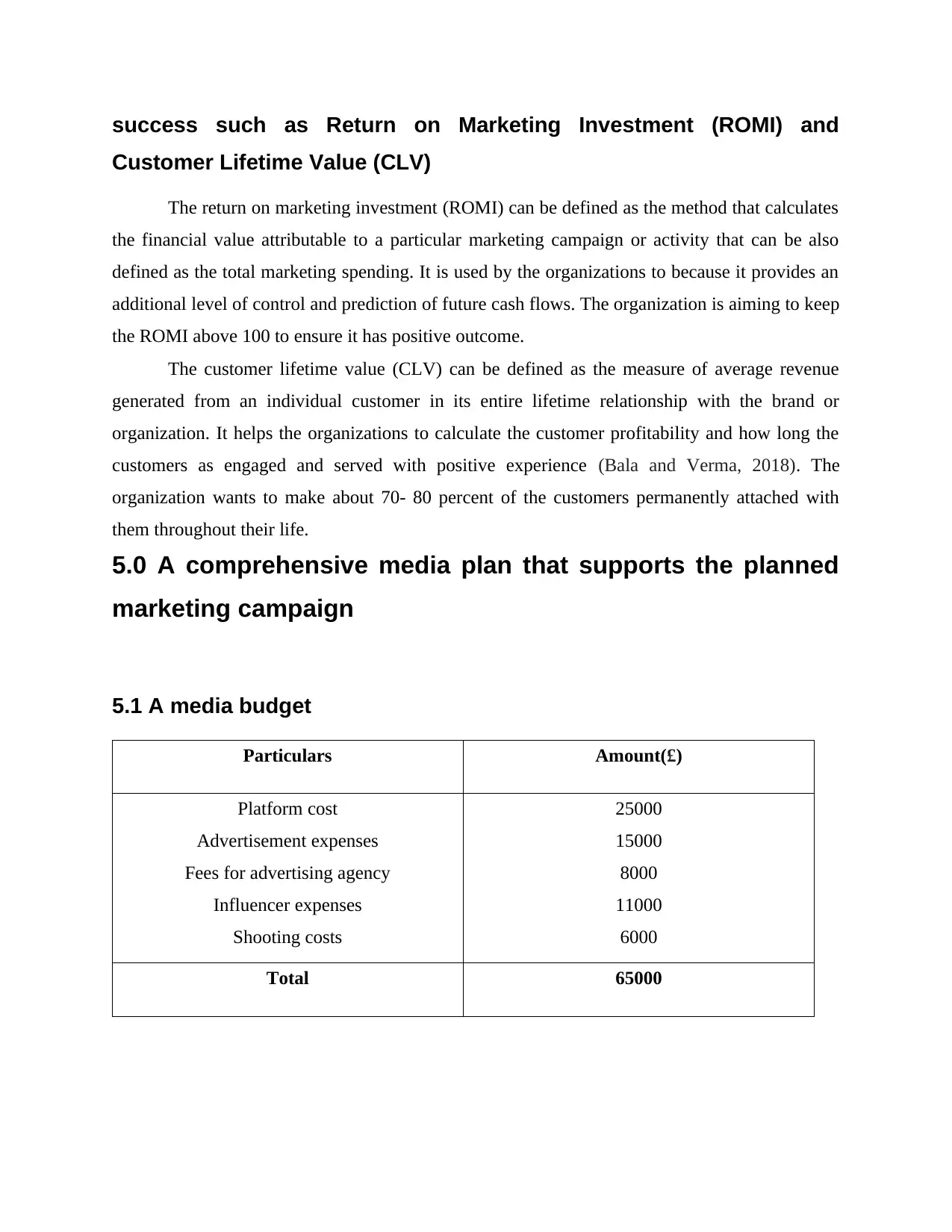
success such as Return on Marketing Investment (ROMI) and
Customer Lifetime Value (CLV)
The return on marketing investment (ROMI) can be defined as the method that calculates
the financial value attributable to a particular marketing campaign or activity that can be also
defined as the total marketing spending. It is used by the organizations to because it provides an
additional level of control and prediction of future cash flows. The organization is aiming to keep
the ROMI above 100 to ensure it has positive outcome.
The customer lifetime value (CLV) can be defined as the measure of average revenue
generated from an individual customer in its entire lifetime relationship with the brand or
organization. It helps the organizations to calculate the customer profitability and how long the
customers as engaged and served with positive experience (Bala and Verma, 2018). The
organization wants to make about 70- 80 percent of the customers permanently attached with
them throughout their life.
5.0 A comprehensive media plan that supports the planned
marketing campaign
5.1 A media budget
Particulars Amount(£)
Platform cost
Advertisement expenses
Fees for advertising agency
Influencer expenses
Shooting costs
25000
15000
8000
11000
6000
Total 65000
Customer Lifetime Value (CLV)
The return on marketing investment (ROMI) can be defined as the method that calculates
the financial value attributable to a particular marketing campaign or activity that can be also
defined as the total marketing spending. It is used by the organizations to because it provides an
additional level of control and prediction of future cash flows. The organization is aiming to keep
the ROMI above 100 to ensure it has positive outcome.
The customer lifetime value (CLV) can be defined as the measure of average revenue
generated from an individual customer in its entire lifetime relationship with the brand or
organization. It helps the organizations to calculate the customer profitability and how long the
customers as engaged and served with positive experience (Bala and Verma, 2018). The
organization wants to make about 70- 80 percent of the customers permanently attached with
them throughout their life.
5.0 A comprehensive media plan that supports the planned
marketing campaign
5.1 A media budget
Particulars Amount(£)
Platform cost
Advertisement expenses
Fees for advertising agency
Influencer expenses
Shooting costs
25000
15000
8000
11000
6000
Total 65000
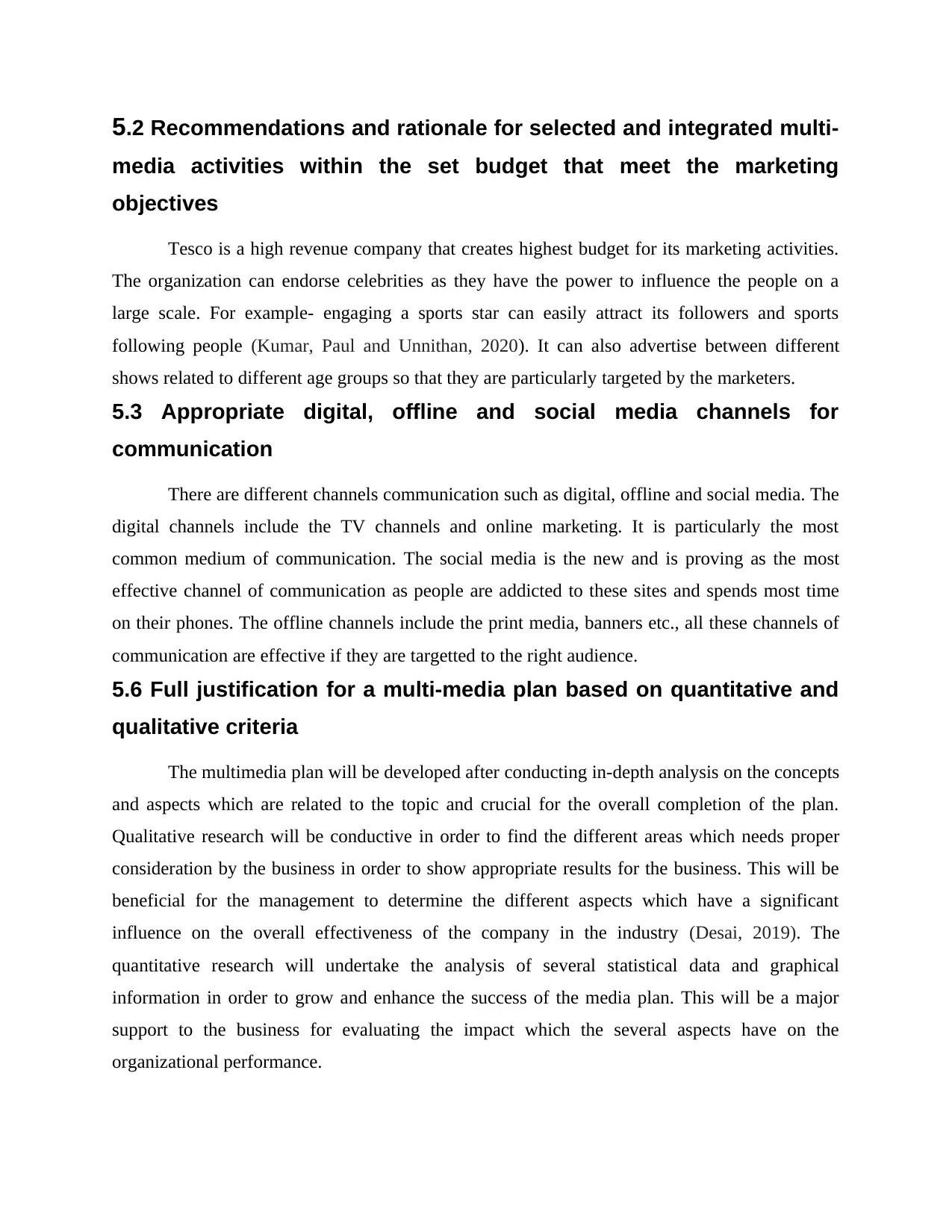
5.2 Recommendations and rationale for selected and integrated multi-
media activities within the set budget that meet the marketing
objectives
Tesco is a high revenue company that creates highest budget for its marketing activities.
The organization can endorse celebrities as they have the power to influence the people on a
large scale. For example- engaging a sports star can easily attract its followers and sports
following people (Kumar, Paul and Unnithan, 2020). It can also advertise between different
shows related to different age groups so that they are particularly targeted by the marketers.
5.3 Appropriate digital, offline and social media channels for
communication
There are different channels communication such as digital, offline and social media. The
digital channels include the TV channels and online marketing. It is particularly the most
common medium of communication. The social media is the new and is proving as the most
effective channel of communication as people are addicted to these sites and spends most time
on their phones. The offline channels include the print media, banners etc., all these channels of
communication are effective if they are targetted to the right audience.
5.6 Full justification for a multi-media plan based on quantitative and
qualitative criteria
The multimedia plan will be developed after conducting in-depth analysis on the concepts
and aspects which are related to the topic and crucial for the overall completion of the plan.
Qualitative research will be conductive in order to find the different areas which needs proper
consideration by the business in order to show appropriate results for the business. This will be
beneficial for the management to determine the different aspects which have a significant
influence on the overall effectiveness of the company in the industry (Desai, 2019). The
quantitative research will undertake the analysis of several statistical data and graphical
information in order to grow and enhance the success of the media plan. This will be a major
support to the business for evaluating the impact which the several aspects have on the
organizational performance.
media activities within the set budget that meet the marketing
objectives
Tesco is a high revenue company that creates highest budget for its marketing activities.
The organization can endorse celebrities as they have the power to influence the people on a
large scale. For example- engaging a sports star can easily attract its followers and sports
following people (Kumar, Paul and Unnithan, 2020). It can also advertise between different
shows related to different age groups so that they are particularly targeted by the marketers.
5.3 Appropriate digital, offline and social media channels for
communication
There are different channels communication such as digital, offline and social media. The
digital channels include the TV channels and online marketing. It is particularly the most
common medium of communication. The social media is the new and is proving as the most
effective channel of communication as people are addicted to these sites and spends most time
on their phones. The offline channels include the print media, banners etc., all these channels of
communication are effective if they are targetted to the right audience.
5.6 Full justification for a multi-media plan based on quantitative and
qualitative criteria
The multimedia plan will be developed after conducting in-depth analysis on the concepts
and aspects which are related to the topic and crucial for the overall completion of the plan.
Qualitative research will be conductive in order to find the different areas which needs proper
consideration by the business in order to show appropriate results for the business. This will be
beneficial for the management to determine the different aspects which have a significant
influence on the overall effectiveness of the company in the industry (Desai, 2019). The
quantitative research will undertake the analysis of several statistical data and graphical
information in order to grow and enhance the success of the media plan. This will be a major
support to the business for evaluating the impact which the several aspects have on the
organizational performance.
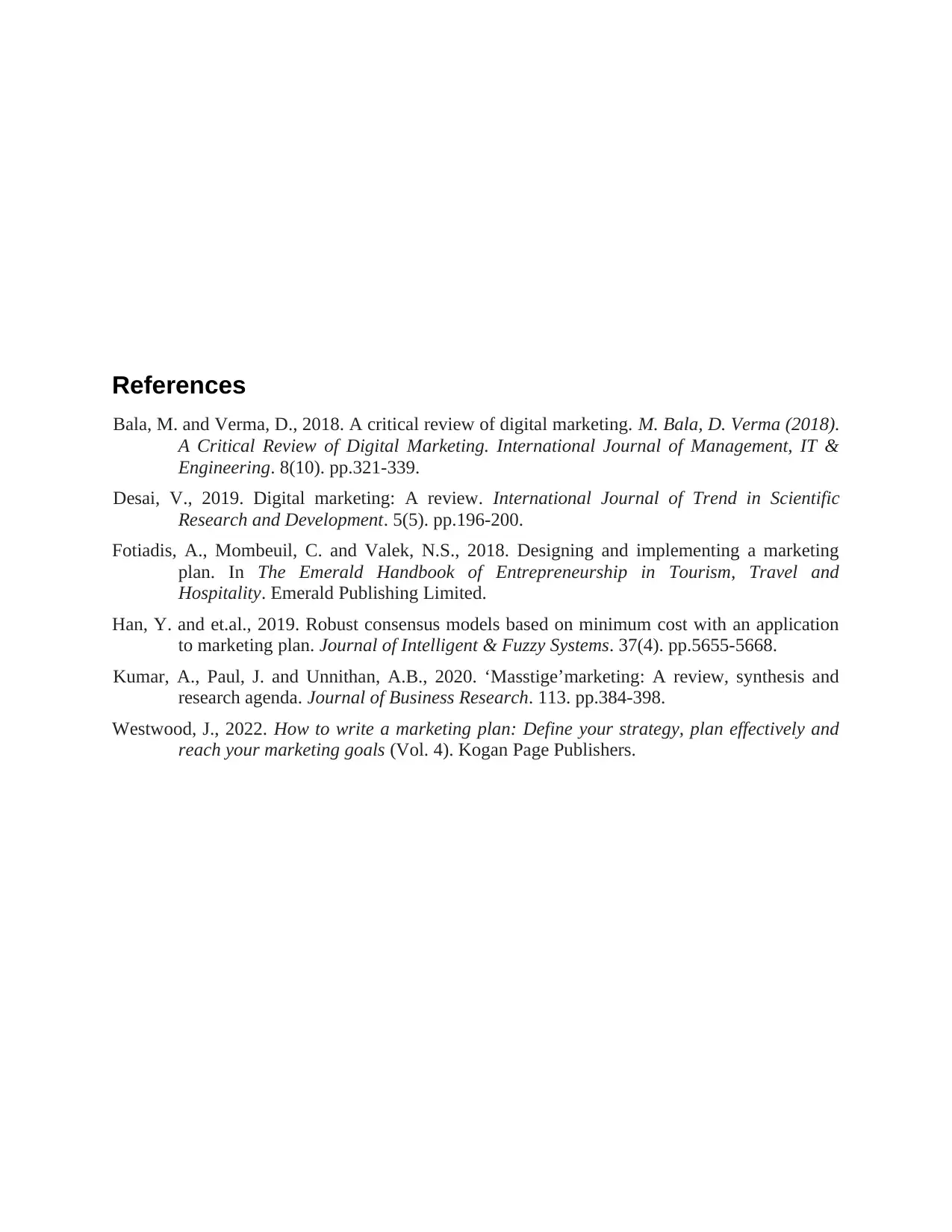
References
Bala, M. and Verma, D., 2018. A critical review of digital marketing. M. Bala, D. Verma (2018).
A Critical Review of Digital Marketing. International Journal of Management, IT &
Engineering. 8(10). pp.321-339.
Desai, V., 2019. Digital marketing: A review. International Journal of Trend in Scientific
Research and Development. 5(5). pp.196-200.
Fotiadis, A., Mombeuil, C. and Valek, N.S., 2018. Designing and implementing a marketing
plan. In The Emerald Handbook of Entrepreneurship in Tourism, Travel and
Hospitality. Emerald Publishing Limited.
Han, Y. and et.al., 2019. Robust consensus models based on minimum cost with an application
to marketing plan. Journal of Intelligent & Fuzzy Systems. 37(4). pp.5655-5668.
Kumar, A., Paul, J. and Unnithan, A.B., 2020. ‘Masstige’marketing: A review, synthesis and
research agenda. Journal of Business Research. 113. pp.384-398.
Westwood, J., 2022. How to write a marketing plan: Define your strategy, plan effectively and
reach your marketing goals (Vol. 4). Kogan Page Publishers.
Bala, M. and Verma, D., 2018. A critical review of digital marketing. M. Bala, D. Verma (2018).
A Critical Review of Digital Marketing. International Journal of Management, IT &
Engineering. 8(10). pp.321-339.
Desai, V., 2019. Digital marketing: A review. International Journal of Trend in Scientific
Research and Development. 5(5). pp.196-200.
Fotiadis, A., Mombeuil, C. and Valek, N.S., 2018. Designing and implementing a marketing
plan. In The Emerald Handbook of Entrepreneurship in Tourism, Travel and
Hospitality. Emerald Publishing Limited.
Han, Y. and et.al., 2019. Robust consensus models based on minimum cost with an application
to marketing plan. Journal of Intelligent & Fuzzy Systems. 37(4). pp.5655-5668.
Kumar, A., Paul, J. and Unnithan, A.B., 2020. ‘Masstige’marketing: A review, synthesis and
research agenda. Journal of Business Research. 113. pp.384-398.
Westwood, J., 2022. How to write a marketing plan: Define your strategy, plan effectively and
reach your marketing goals (Vol. 4). Kogan Page Publishers.
Paraphrase This Document
Need a fresh take? Get an instant paraphrase of this document with our AI Paraphraser

1 out of 20
Related Documents
Your All-in-One AI-Powered Toolkit for Academic Success.
+13062052269
info@desklib.com
Available 24*7 on WhatsApp / Email
![[object Object]](/_next/static/media/star-bottom.7253800d.svg)
Unlock your academic potential
© 2024 | Zucol Services PVT LTD | All rights reserved.
